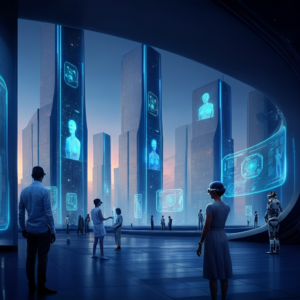Teleportation—a concept born from the pages of science fiction—has captivated the human imagination for decades. Popularized through stories like Star Trek and The Fly, the notion of instantly transporting people or objects from one location to another has always been a fascinating “what if.” But what if teleportation actually became a reality? Could this once-fictional idea revolutionize how we travel, live, and connect? And what challenges would accompany such a groundbreaking innovation?
This blog explores the science of teleportation, the technology it would require, and the profound implications it could have on travel, society, and ethics. Whether you’re a tech enthusiast, a sci-fi fan, or someone who dreams of skipping long flights, teleportation is bound to spark your imagination.
The Science Behind Teleportation
At its core, teleportation involves transmitting physical matter from one place to another without traveling through the intervening space. Sounds incredible, right? Scientific discussions of teleportation, however, currently center around quantum entanglement—a phenomenon where two or more particles become interconnected in such a way that the state of one particle instantly influences the state of another, no matter how far apart they are.
A Quantum Leap
Quantum teleportation is a term you might hear in this discussion. Not to be confused with physical teleportation, this process involves transferring the quantum state of one particle to another, while the original particle is destroyed. Researchers have already achieved this on a basic level. For example, scientists have successfully teleported quantum bits, or qubits, across distances of up to several kilometers using fiber optic cables and satellite technology.
While conventional teleportation might sound similar to sci-fi teleportation, there’s a massive gap between transmitting information about a quantum state and transporting a person or an object. However, these early breakthroughs in quantum entanglement lay an important scientific foundation to expand upon.
Current Advancements
Breakthroughs in quantum computing, particle physics, and data transmission bring us closer to exploring teleportation in practical terms. Recent experiments have demonstrated the robust capabilities of quantum networks—a basic infrastructure for sharing quantum particles.
Yet, challenges abound. The level of data required to describe and recreate a human body, down to molecular or atomic levels, would be astronomical. Processing and transmitting this data faster than the speed of light, while also ensuring perfect accuracy, remains a daunting obstacle.
Teleportation Technology: How It Works
Hypothetical Mechanisms
If teleportation became feasible, it would likely rely on advanced scanning and reconstruction technologies. Here’s how it might work in theory:
- Scanning: A powerful scanner maps every atom within a person or object, recording its precise configuration.
- Destruction: The original object or individual is disassembled at the molecular or quantum level.
- Transmission: The data is transmitted electronically or via a quantum network to the receiving location.
- Reconstruction: Advanced machinery reconstructs the person or object at the new location with atomic accuracy.
Challenges and Limitations
- Massive Data Transfer: Scanning and transmitting even a teaspoon of matter would involve massive amounts of data—far beyond current technology’s capacity.
- Biological Concerns: Can consciousness, memory, or individuality be retained through such a process?
- Energy Demand: The energy required to disassemble and reassemble atoms or transfer data could be staggering.
The Impact of Teleportation on Travel and Daily Life
Imagine a future where teleportation replaces airplanes, trains, and cars entirely. What might this mean for travel, logistics, and everyday life?
Reducing Travel Time
Long waits at airports and hours spent on international flights could become a thing of the past. Trips across continents could take seconds rather than days, giving people more time to spend with loved ones or focus on hobbies and careers.
Environmental Benefits
With no physical vehicles involved, teleportation could cut down greenhouse gas emissions significantly. Of course, this assumes that the energy involved in teleportation is clean and sustainable.
Transforming Industries
Teleportation could revolutionize logistics, medical services, and disaster relief. Supplies and equipment could reach remote or disaster-affected areas in moments. Surgeons could instantly travel across the globe to perform life-saving procedures.
Ethical, Legal, and Societal Implications
Teleportation presents exciting possibilities, but it also raises profound questions.
Privacy and Security
How do we ensure that people and their scanned data remain private and protected? Could hackers interfere mid-transport or duplicate someone dishonestly?
Equitable Access
Would teleportation be affordable and accessible to all, or would it deepen existing economic and societal divides?
Cultural Impact
Transportation has played a historical and cultural role in shaping human connections and civilizations. Instant travel could erode traditional travel practices and even the concept of physical distance itself.
The Future of Teleportation
While full-scale human teleportation remains far from our grasp, researchers and technologists continue to push the boundaries of what’s possible. Current efforts in quantum teleportation and quantum computing signal significant advancements in understanding and applying quantum mechanics. With sustained progress, teleportation might one day transition from science fiction to science fact.
But this won’t happen overnight. The technology has to first overcome steep scientific, technical, and ethical hurdles. The realistic timeline for teleportation’s emergence—if achievable—likely ranges between decades and centuries.
What Could Teleportation Mean for Humanity?
Teleportation represents both an exhilarating technological leap and an ethical conundrum. Can we guarantee the process is safe, equitable, and beneficial for society at large? And how might instant travel reshape—and perhaps enhance—our global connections, industries, and daily lives?
We may be decades away from those answers, but now is the time to envision, debate, and influence the foundation of this revolutionary concept. After all, every great breakthrough starts with imagination.
What do you think? Could teleportation be humanity’s next great leap forward, or is it better left in the realm of sci-fi? Share your thoughts in the comments below—perhaps the next big idea will come from you.







